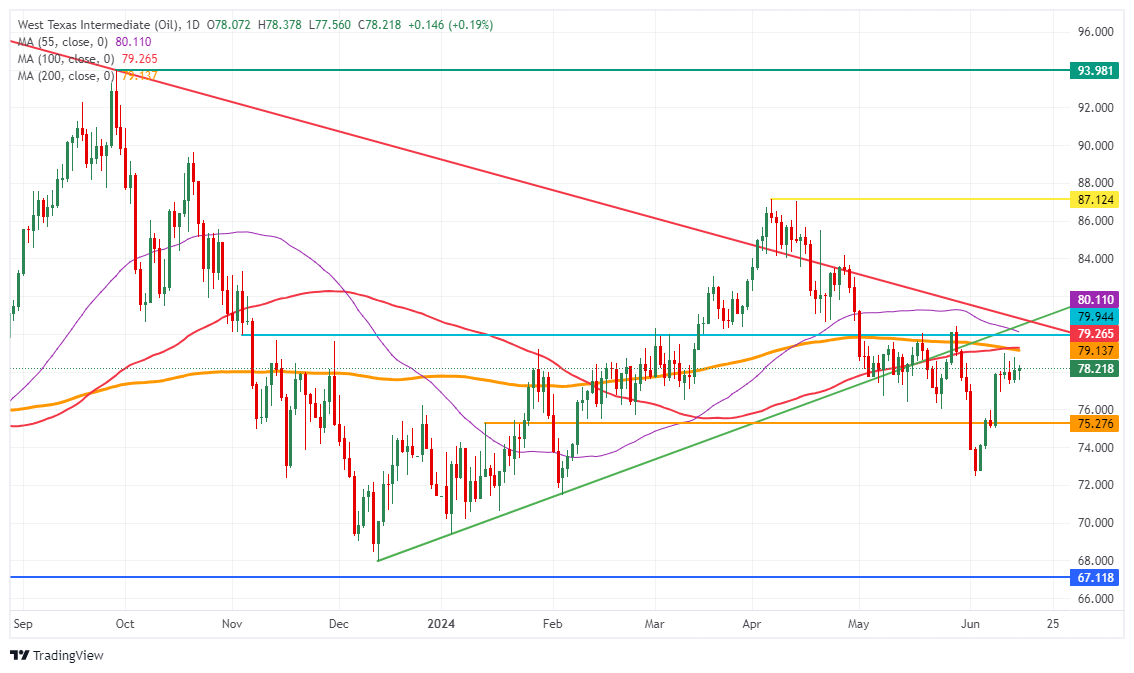- Oil keeps pushing higher ahead of the US trading session.
- Demand recovery faces substantial issues in the medium turn with the shift away from fossil fuels.
- The US Dollar Index trades above 105.50 on the back of turmoil in the European bond market.
Oil prices are in positive territory at the start of this week, despite no big headlines driving up prices. It looks like traders are evaluating and estimating how the shift to Electric Vehicles will impact demand in the medium to long term projections, while an uprising in fuel demand over the summer will certainly lead to an uprising in Oil prices in the short term. This could translate to smaller volumes traded ahead of more clarity on how to approach this change in narrative short term versus long term.
Meanwhile, the US Dollar Index (DXY) is trading above 105.50, with additional help from the European bond markets, which are in distress. Sovereign bonds are seeing spreads, the difference between the yield in maturity from one country against another, widening. This could cause issues for the European Central Bank (ECB) as it could cause some difficult financial conditions for some countries that need to refinance their sovereign debt in financial markets.
At the time of writing, Crude Oil (WTI) trades at $78.66 and Brent Crude at $82.79
Oil news and market movers: Squeezing higher
- Vortex data revealed that the amount of crude oil held worldwide on tankers that have been stationary for at least seven days fell to 78.66m bbl as of June 14, Bloomberg reported. That is a fall of nearly 12%.
- Jet Fuel demand will keep growing as the demand for plane travel continues to pick up, Bloomberg data reported.
- OPEC sticks to its bullish outlook against the forecast from the International Energy Agency (IEA) and expects more demand pickup by the fall and winter of this year.
- Mixed economic data from China makes traders question whether China will be able to keep up its current demand resurgence, Reuters reports.
Oil Technical Analysis: Despite sluggish demand, some room for upside
Oil price remains a bit puzzling on what to do next. Although several commodity desks and analysts warn of the green shift that will hurt Oil demand in the long run, OPEC keeps sticking to its bullish outlook. Expect to see further consolidation until more pieces of the puzzle fall into place to give traders more outlook on demand.
Looking up, the key two levels ahead of $80.00 are the 100-day and 200-day Simple Moving Averages (SMA) at $79.26 and $79.13, respectively. Next, the 55-day Simple Moving Average (SMA) at $80.11 is a level with a lot of resistance where any recovery rally could pause. Once broken through, the road looks quite open to $87.12.
On the other side, the $76.00 marker is still acting as a support, with the $75.27 level playing a crucial role if traders still want to have an option to head back to $80.00. However, risks are skewed towards another leg lower if the US Federal Reserve (Fed) keeps its hawkish tone, sending Oil further down below $70.00.
US WTI Crude Oil: Daily Chart
WTI Oil FAQs
WTI Oil is a type of Crude Oil sold on international markets. The WTI stands for West Texas Intermediate, one of three major types including Brent and Dubai Crude. WTI is also referred to as “light” and “sweet” because of its relatively low gravity and sulfur content respectively. It is considered a high quality Oil that is easily refined. It is sourced in the United States and distributed via the Cushing hub, which is considered “The Pipeline Crossroads of the World”. It is a benchmark for the Oil market and WTI price is frequently quoted in the media.
Like all assets, supply and demand are the key drivers of WTI Oil price. As such, global growth can be a driver of increased demand and vice versa for weak global growth. Political instability, wars, and sanctions can disrupt supply and impact prices. The decisions of OPEC, a group of major Oil-producing countries, is another key driver of price. The value of the US Dollar influences the price of WTI Crude Oil, since Oil is predominantly traded in US Dollars, thus a weaker US Dollar can make Oil more affordable and vice versa.
The weekly Oil inventory reports published by the American Petroleum Institute (API) and the Energy Information Agency (EIA) impact the price of WTI Oil. Changes in inventories reflect fluctuating supply and demand. If the data shows a drop in inventories it can indicate increased demand, pushing up Oil price. Higher inventories can reflect increased supply, pushing down prices. API’s report is published every Tuesday and EIA’s the day after. Their results are usually similar, falling within 1% of each other 75% of the time. The EIA data is considered more reliable, since it is a government agency.
OPEC (Organization of the Petroleum Exporting Countries) is a group of 13 Oil-producing nations who collectively decide production quotas for member countries at twice-yearly meetings. Their decisions often impact WTI Oil prices. When OPEC decides to lower quotas, it can tighten supply, pushing up Oil prices. When OPEC increases production, it has the opposite effect. OPEC+ refers to an expanded group that includes ten extra non-OPEC members, the most notable of which is Russia.

